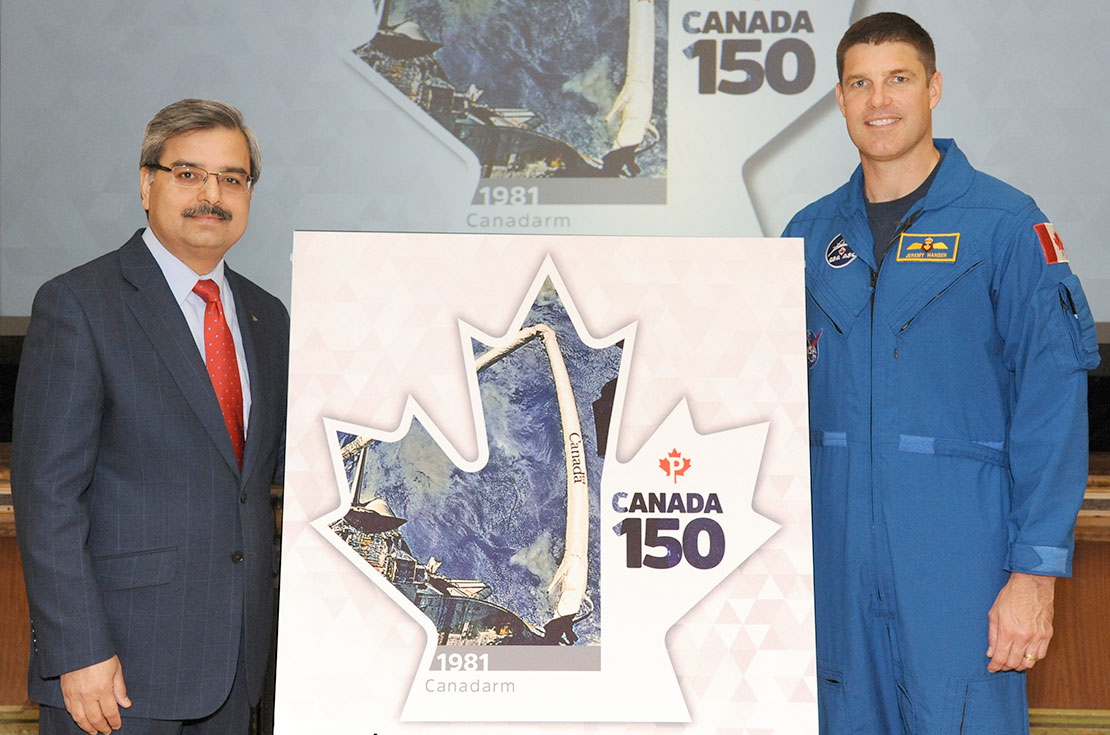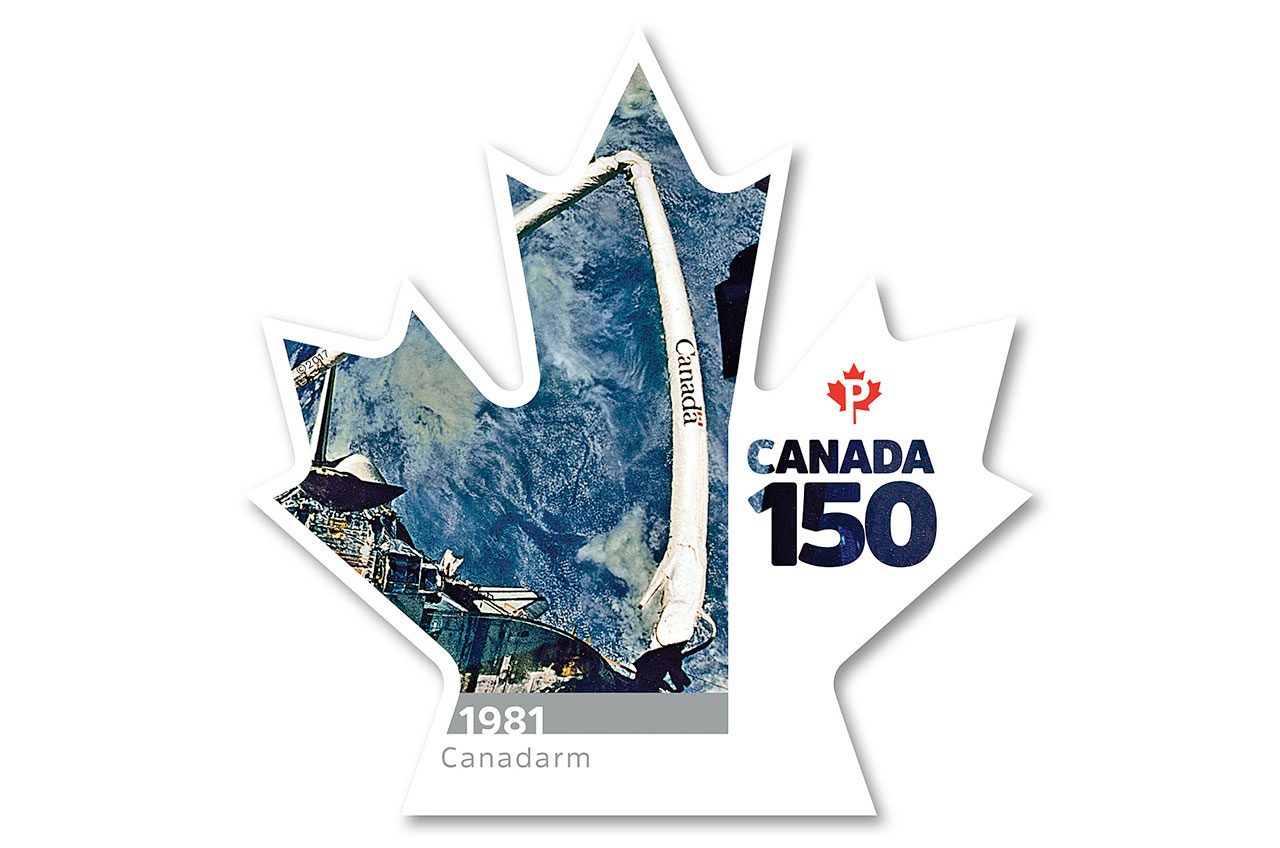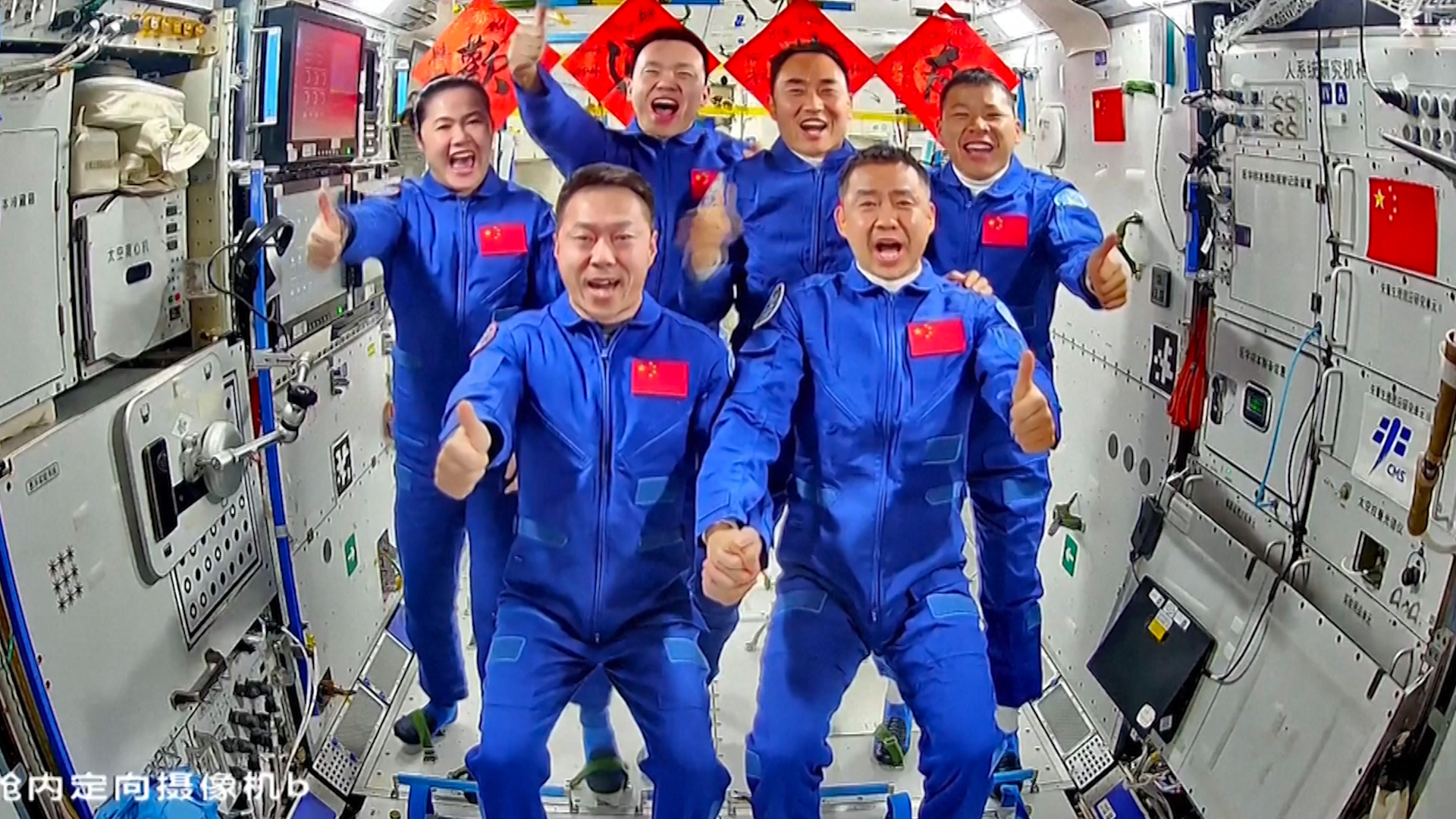Canada Post Reveals Stamp for Canadarm Space Shuttle Robotic Arm

More than three and a half decades after it first reached out into space, the Canadarm is set to extend its legacy by appearing on a new postage stamp.
Canada Post, Canada's postal service, revealed the new maple leaf-shaped stamp at a ceremony held at the Glen Ames Senior Public School in Toronto on April 28. Deepak Chopra, Canada Post's president and CEO, was joined by Canadian Space Agency astronaut Jeremy Hansen for the stamp's unveiling.
"Our stamps tell the story of Canada, its people, and our country's accomplishments — both on Earth and beyond," said Chopra. [Photos: Space Age Postage Stamps Through History]
According to Canada Post, the Canadarm postage stamp commemorates Canada's achievements in space, science, technology and innovation.
First tested in orbit on Nov. 13, 1981, during the second mission of NASA's space shuttle Columbia, the Canadarm shuttle remote manipulator system (SRMS) made possible the deployment and recovery of satellites from the payload bay of the shuttle and played a critical role in the assembly of the International Space Station.
The 50-foot-long (15-meter) robotic arms — five were flown between 1981 and 2011 — featured six rotating joints and could maneuver items in space that had a mass equivalent to a fully-loaded city bus.
The new Canadarm stamp, which goes on sale on June 1, features a photo of the robotic arm taken on April 25, 1990 as it grappled the Hubble Space Telescope in the payload bay of the shuttle Discovery to place the observatory into orbit. The Permanent-rate stamp is the third in a series of ten being issued to celebrate Canada's sesquicentennial (the two previous stamps revealed to date honor Canada's Constitution and Expo 67, the world's fair held in Montreal in 1967).
Get the Space.com Newsletter
Breaking space news, the latest updates on rocket launches, skywatching events and more!

"Canadian technologies have played a major role in space exploration," Canada Post inscribed on the stamp's "first day of issue" postmarked envelope (or "cover"). "Some of our most famous inventions include the legs of the Apollo 11 lunar module that landed the first man on the moon and the Canadarm that captured and released satellites and transported spacewalkers of various shuttle missions for three decades."
The Canadarm stamp was designed by Roy White and Liz Wurzinger of Subplot Design in Vancouver for the Canada Post. The self-adhesive stamp, which measures 1.6 inches square (40 by 40 millimeters), will be available in a booklet that includes all ten "Canada 150" stamps, or as part of a gummed pane of the same.
The Canadarm increased Canada's partnership with NASA on human spaceflight endeavors, including the launch of Canadian astronauts on 16 space shuttle or space station missions. The robot arm led directly to the larger and more advanced Canadarm2, which has been in use outside the International Space Station since 2001, and "Dextre," the special purpose dexterous manipulator, a two-armed robot added to the orbiting laboratory in 2008.
The Canada 150 Canadarm postage stamp is at least the third Canadian commemorative to feature the robotic arm.
In 1986, the SRMS was illustrated in schematic form on a Canada Day stamp that marked "Canadian Innovations in Transportation." Twenty-five years later in 2011, the same year the space shuttle — and with it, the Canadarm — was retired, the manipulator was shown on a stamp celebrating "Canadian Pride."
The robot arm was also included on the selvage, or border, of a 2003 set of stamps depicting the Canadian astronauts who have flown in space.
Watch a video of the unveiling of the "Canada 150" Canadarm stamp at collectSPACE.
Follow collectSPACE.com on Facebook and on Twitter at @collectSPACE. Copyright 2017 collectSPACE.com. All rights reserved.
Join our Space Forums to keep talking space on the latest missions, night sky and more! And if you have a news tip, correction or comment, let us know at: community@space.com.

Robert Pearlman is a space historian, journalist and the founder and editor of collectSPACE.com, a daily news publication and community devoted to space history with a particular focus on how and where space exploration intersects with pop culture. Pearlman is also a contributing writer for Space.com and co-author of "Space Stations: The Art, Science, and Reality of Working in Space” published by Smithsonian Books in 2018.In 2009, he was inducted into the U.S. Space Camp Hall of Fame in Huntsville, Alabama. In 2021, he was honored by the American Astronautical Society with the Ordway Award for Sustained Excellence in Spaceflight History. In 2023, the National Space Club Florida Committee recognized Pearlman with the Kolcum News and Communications Award for excellence in telling the space story along the Space Coast and throughout the world.










